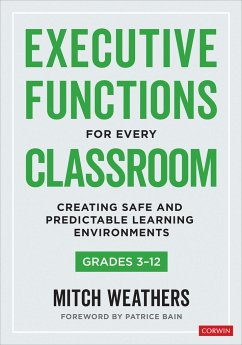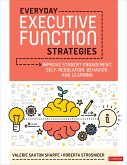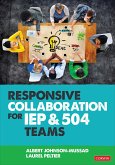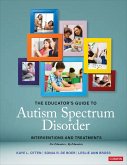Mitch Weathers
Executive Functions for Every Classroom, Grades 3-12
Creating Safe and Predictable Learning Environments
Mitch Weathers
Executive Functions for Every Classroom, Grades 3-12
Creating Safe and Predictable Learning Environments
- Broschiertes Buch
- Merkliste
- Auf die Merkliste
- Bewerten Bewerten
- Teilen
- Produkt teilen
- Produkterinnerung
- Produkterinnerung
Every educator wants to know: What has the greatest impact on student success? The answer: executive function skills. They are crucial for students¿ academic success and personal growth, yet many of our students lack the skills required to engage in learning, such as organization, planning, time management, and self-regulation. > * The three keys to teaching executive functions: Clarity, Modeling, and Routine * An explanation of the specific executive functioning skills essential for student success * Strategies for students to practice executive functions within the context of what they are…mehr
Andere Kunden interessierten sich auch für
![Everyday Executive Function Strategies Everyday Executive Function Strategies]() Valerie Saxton SharpeEveryday Executive Function Strategies48,99 €
Valerie Saxton SharpeEveryday Executive Function Strategies48,99 €![Responsive Collaboration for IEP and 504 Teams Responsive Collaboration for IEP and 504 Teams]() Albert Johnson-Mussad (Educational consultant and coach)Responsive Collaboration for IEP and 504 Teams48,99 €
Albert Johnson-Mussad (Educational consultant and coach)Responsive Collaboration for IEP and 504 Teams48,99 €![The Educator's Guide to Autism Spectrum Disorder The Educator's Guide to Autism Spectrum Disorder]() The Educator's Guide to Autism Spectrum Disorder51,99 €
The Educator's Guide to Autism Spectrum Disorder51,99 €![Cambridge Checkpoint Mathematics Challenge Workbook 8 Cambridge Checkpoint Mathematics Challenge Workbook 8]() Greg ByrdCambridge Checkpoint Mathematics Challenge Workbook 812,99 €
Greg ByrdCambridge Checkpoint Mathematics Challenge Workbook 812,99 €![Breakthrough to CLIL for Physics Age 14+ Workbook Breakthrough to CLIL for Physics Age 14+ Workbook]() David SangBreakthrough to CLIL for Physics Age 14+ Workbook14,99 €
David SangBreakthrough to CLIL for Physics Age 14+ Workbook14,99 €![Cambridge Checkpoint Mathematics Skills Builder Workbook 7 Cambridge Checkpoint Mathematics Skills Builder Workbook 7]() Greg ByrdCambridge Checkpoint Mathematics Skills Builder Workbook 712,99 €
Greg ByrdCambridge Checkpoint Mathematics Skills Builder Workbook 712,99 €![Cambridge Checkpoint Mathematics Challenge Workbook 9 Cambridge Checkpoint Mathematics Challenge Workbook 9]() Greg ByrdCambridge Checkpoint Mathematics Challenge Workbook 912,99 €
Greg ByrdCambridge Checkpoint Mathematics Challenge Workbook 912,99 €-
-
-
Every educator wants to know: What has the greatest impact on student success? The answer: executive function skills. They are crucial for students¿ academic success and personal growth, yet many of our students lack the skills required to engage in learning, such as organization, planning, time management, and self-regulation. > * The three keys to teaching executive functions: Clarity, Modeling, and Routine * An explanation of the specific executive functioning skills essential for student success * Strategies for students to practice executive functions within the context of what they are learning * Practical guidance for establishing a consistent and safe learning environment * Guidance on how to expose all students to this universal MTSS/RTI Tier 1 intervention Educators can empower students to take more risks, improve their academic performance, and prepare them for the future with the help of this innovative resource.
Produktdetails
- Produktdetails
- Verlag: SAGE Publications Inc
- Seitenzahl: 216
- Erscheinungstermin: 6. Juni 2024
- Englisch
- Abmessung: 247mm x 177mm x 12mm
- Gewicht: 454g
- ISBN-13: 9781071919453
- ISBN-10: 1071919458
- Artikelnr.: 69078194
- Herstellerkennzeichnung
- Libri GmbH
- Europaallee 1
- 36244 Bad Hersfeld
- gpsr@libri.de
- Verlag: SAGE Publications Inc
- Seitenzahl: 216
- Erscheinungstermin: 6. Juni 2024
- Englisch
- Abmessung: 247mm x 177mm x 12mm
- Gewicht: 454g
- ISBN-13: 9781071919453
- ISBN-10: 1071919458
- Artikelnr.: 69078194
- Herstellerkennzeichnung
- Libri GmbH
- Europaallee 1
- 36244 Bad Hersfeld
- gpsr@libri.de
Mitch Weathers is a teacher, founder of Organized Binder, Inc. and author of the best selling book, Executive Functions for Every Classroom: Creating Safe and Predictable Learning Environments - Grades 3-12. Together with the Organized Binder team, Mitch works with K-12 schools and colleges in the US and internationally to equip students with executive functioning skills. When he is not working with schools, you can find him running trails training for his next ultramarathon. He lives with his wife and two daughters in Northern California.
Foreword Preface Acknowledgments Introduction Lost in the Wilderness Navigating With Executive Functioning Skills The Two Challenges With Teaching Executive Functions Why Predictable Learning Routines? Three Keys to Teaching Executive Functions Chapter 1. Executive Dysfunction and Disengagement Struggling With "Studentness" We Can
t Afford Executive Dysfunction Any Longer Chapter 1 Reflection Questions Chapter 2. Teaching Executive Functions What are Executive Functioning Skills? The Benefits Clarity, Routine, & Modeling Self-Regulation Through a Daily Routine Conclusion Chapter 2 Reflection Questions Chapter 3. Working Memory: Beginning Routine Designing a Beginning Routine Why the Old Beginning Routine Doesn
t Work Strategies to Make Your Beginning Routine Better Beginning Routine Example Adjustments and Considerations Self-Regulation Through the Beginning Routine Conclusion Chapter 3 Reflection Questions Chapter 4. Working Memory: The Concluding Routine How to Receive Authentic Feedback Designing Your Concluding Routine Why the Old Concluding Routine Doesn
t Work Strategies to Make Your Concluding Routine Better Concluding Routine Example Adjustments and Considerations I Dare You to Try It Self-Regulation Through the Concluding Routine Conclusion Chapter 4 Reflection Questions Chapter 5. Time & Task Management: The Agenda Developing Time & Task Management Skills Why the Old Agenda Doesn't Work Strategies to Make Your Agenda Better Agenda Template Adjustments and Considerations Self-Regulation Through Agendas Conclusion Chapter 5 Reflection Questions Chapter 6. Organization: Tables of Contents and Academic Toolkits What is a Table of Contents? Why the Old Table of Contents Doesn't Work Strategies to Make Your Table of Contents Better Table of Contents Example Adjustments and Considerations Academic Toolkits Academic Toolkit Example Self-Regulation Through Tables of Contents and Academic Toolkits Conclusion Chapter 6 Reflection Questions Chapter 7. Accountability: Portfolio Checks Accountability Starts With Expectations Accountability Through Portfolio Checks Designing Your Portfolio Check Portfolio Check Example Adjustments and Considerations Self-Regulation Through Portfolio Checks Conclusion Chapter 7 Reflection Questions Chapter 8. Goal Setting Why the Old Goal Setting Doesn't Work Strategies to Make Goal Setting Better Goal Setting Example Adjustments and Considerations Self-Regulation Through Goal-Setting Conclusion Chapter 8 Reflection Questions Chapter 9. Conclusion Self-Regulation Self-Efficacy and Internal Motivation Tenacity (Formerly Known as Grit) Executive Functions as Transferable Skills Content Area Gains Family Engagement Signing Off Appendix: Effect Size Glossary References
t Afford Executive Dysfunction Any Longer Chapter 1 Reflection Questions Chapter 2. Teaching Executive Functions What are Executive Functioning Skills? The Benefits Clarity, Routine, & Modeling Self-Regulation Through a Daily Routine Conclusion Chapter 2 Reflection Questions Chapter 3. Working Memory: Beginning Routine Designing a Beginning Routine Why the Old Beginning Routine Doesn
t Work Strategies to Make Your Beginning Routine Better Beginning Routine Example Adjustments and Considerations Self-Regulation Through the Beginning Routine Conclusion Chapter 3 Reflection Questions Chapter 4. Working Memory: The Concluding Routine How to Receive Authentic Feedback Designing Your Concluding Routine Why the Old Concluding Routine Doesn
t Work Strategies to Make Your Concluding Routine Better Concluding Routine Example Adjustments and Considerations I Dare You to Try It Self-Regulation Through the Concluding Routine Conclusion Chapter 4 Reflection Questions Chapter 5. Time & Task Management: The Agenda Developing Time & Task Management Skills Why the Old Agenda Doesn't Work Strategies to Make Your Agenda Better Agenda Template Adjustments and Considerations Self-Regulation Through Agendas Conclusion Chapter 5 Reflection Questions Chapter 6. Organization: Tables of Contents and Academic Toolkits What is a Table of Contents? Why the Old Table of Contents Doesn't Work Strategies to Make Your Table of Contents Better Table of Contents Example Adjustments and Considerations Academic Toolkits Academic Toolkit Example Self-Regulation Through Tables of Contents and Academic Toolkits Conclusion Chapter 6 Reflection Questions Chapter 7. Accountability: Portfolio Checks Accountability Starts With Expectations Accountability Through Portfolio Checks Designing Your Portfolio Check Portfolio Check Example Adjustments and Considerations Self-Regulation Through Portfolio Checks Conclusion Chapter 7 Reflection Questions Chapter 8. Goal Setting Why the Old Goal Setting Doesn't Work Strategies to Make Goal Setting Better Goal Setting Example Adjustments and Considerations Self-Regulation Through Goal-Setting Conclusion Chapter 8 Reflection Questions Chapter 9. Conclusion Self-Regulation Self-Efficacy and Internal Motivation Tenacity (Formerly Known as Grit) Executive Functions as Transferable Skills Content Area Gains Family Engagement Signing Off Appendix: Effect Size Glossary References
Foreword Preface Acknowledgments Introduction Lost in the Wilderness Navigating With Executive Functioning Skills The Two Challenges With Teaching Executive Functions Why Predictable Learning Routines? Three Keys to Teaching Executive Functions Chapter 1. Executive Dysfunction and Disengagement Struggling With "Studentness" We Can
t Afford Executive Dysfunction Any Longer Chapter 1 Reflection Questions Chapter 2. Teaching Executive Functions What are Executive Functioning Skills? The Benefits Clarity, Routine, & Modeling Self-Regulation Through a Daily Routine Conclusion Chapter 2 Reflection Questions Chapter 3. Working Memory: Beginning Routine Designing a Beginning Routine Why the Old Beginning Routine Doesn
t Work Strategies to Make Your Beginning Routine Better Beginning Routine Example Adjustments and Considerations Self-Regulation Through the Beginning Routine Conclusion Chapter 3 Reflection Questions Chapter 4. Working Memory: The Concluding Routine How to Receive Authentic Feedback Designing Your Concluding Routine Why the Old Concluding Routine Doesn
t Work Strategies to Make Your Concluding Routine Better Concluding Routine Example Adjustments and Considerations I Dare You to Try It Self-Regulation Through the Concluding Routine Conclusion Chapter 4 Reflection Questions Chapter 5. Time & Task Management: The Agenda Developing Time & Task Management Skills Why the Old Agenda Doesn't Work Strategies to Make Your Agenda Better Agenda Template Adjustments and Considerations Self-Regulation Through Agendas Conclusion Chapter 5 Reflection Questions Chapter 6. Organization: Tables of Contents and Academic Toolkits What is a Table of Contents? Why the Old Table of Contents Doesn't Work Strategies to Make Your Table of Contents Better Table of Contents Example Adjustments and Considerations Academic Toolkits Academic Toolkit Example Self-Regulation Through Tables of Contents and Academic Toolkits Conclusion Chapter 6 Reflection Questions Chapter 7. Accountability: Portfolio Checks Accountability Starts With Expectations Accountability Through Portfolio Checks Designing Your Portfolio Check Portfolio Check Example Adjustments and Considerations Self-Regulation Through Portfolio Checks Conclusion Chapter 7 Reflection Questions Chapter 8. Goal Setting Why the Old Goal Setting Doesn't Work Strategies to Make Goal Setting Better Goal Setting Example Adjustments and Considerations Self-Regulation Through Goal-Setting Conclusion Chapter 8 Reflection Questions Chapter 9. Conclusion Self-Regulation Self-Efficacy and Internal Motivation Tenacity (Formerly Known as Grit) Executive Functions as Transferable Skills Content Area Gains Family Engagement Signing Off Appendix: Effect Size Glossary References
t Afford Executive Dysfunction Any Longer Chapter 1 Reflection Questions Chapter 2. Teaching Executive Functions What are Executive Functioning Skills? The Benefits Clarity, Routine, & Modeling Self-Regulation Through a Daily Routine Conclusion Chapter 2 Reflection Questions Chapter 3. Working Memory: Beginning Routine Designing a Beginning Routine Why the Old Beginning Routine Doesn
t Work Strategies to Make Your Beginning Routine Better Beginning Routine Example Adjustments and Considerations Self-Regulation Through the Beginning Routine Conclusion Chapter 3 Reflection Questions Chapter 4. Working Memory: The Concluding Routine How to Receive Authentic Feedback Designing Your Concluding Routine Why the Old Concluding Routine Doesn
t Work Strategies to Make Your Concluding Routine Better Concluding Routine Example Adjustments and Considerations I Dare You to Try It Self-Regulation Through the Concluding Routine Conclusion Chapter 4 Reflection Questions Chapter 5. Time & Task Management: The Agenda Developing Time & Task Management Skills Why the Old Agenda Doesn't Work Strategies to Make Your Agenda Better Agenda Template Adjustments and Considerations Self-Regulation Through Agendas Conclusion Chapter 5 Reflection Questions Chapter 6. Organization: Tables of Contents and Academic Toolkits What is a Table of Contents? Why the Old Table of Contents Doesn't Work Strategies to Make Your Table of Contents Better Table of Contents Example Adjustments and Considerations Academic Toolkits Academic Toolkit Example Self-Regulation Through Tables of Contents and Academic Toolkits Conclusion Chapter 6 Reflection Questions Chapter 7. Accountability: Portfolio Checks Accountability Starts With Expectations Accountability Through Portfolio Checks Designing Your Portfolio Check Portfolio Check Example Adjustments and Considerations Self-Regulation Through Portfolio Checks Conclusion Chapter 7 Reflection Questions Chapter 8. Goal Setting Why the Old Goal Setting Doesn't Work Strategies to Make Goal Setting Better Goal Setting Example Adjustments and Considerations Self-Regulation Through Goal-Setting Conclusion Chapter 8 Reflection Questions Chapter 9. Conclusion Self-Regulation Self-Efficacy and Internal Motivation Tenacity (Formerly Known as Grit) Executive Functions as Transferable Skills Content Area Gains Family Engagement Signing Off Appendix: Effect Size Glossary References








